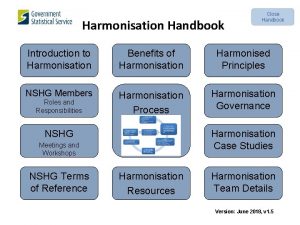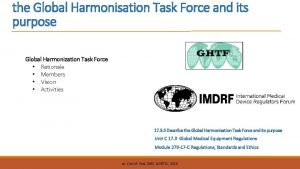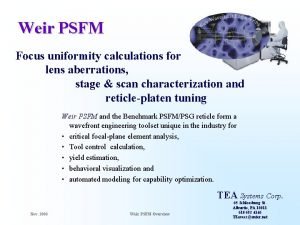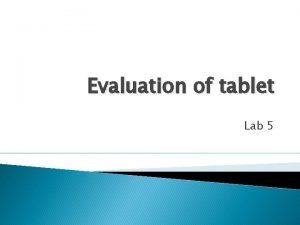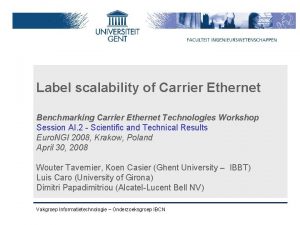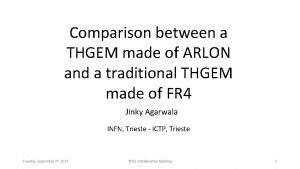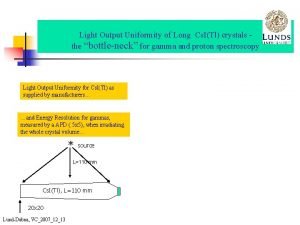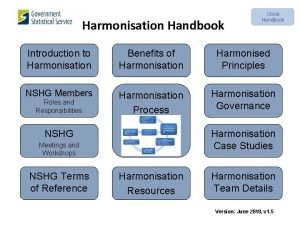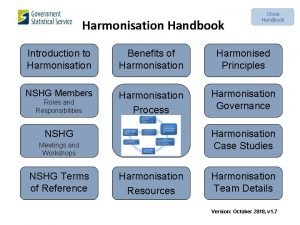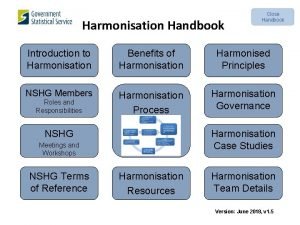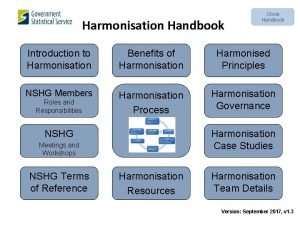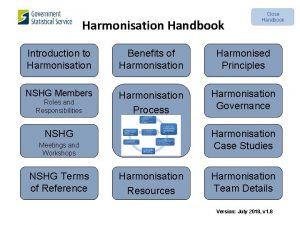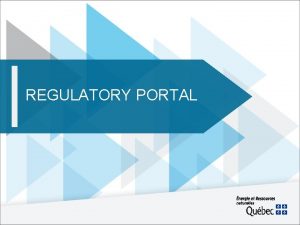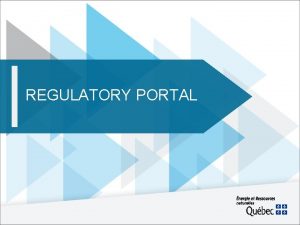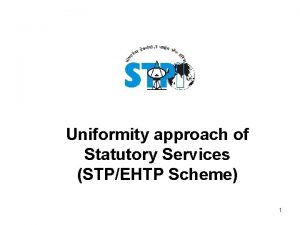Adopting a Critical Approach to Regulatory Uniformity Harmonisation















- Slides: 15

Adopting a Critical Approach to Regulatory Uniformity & Harmonisation Rex Deighton-Smith Centre for Regulatory Studies Monash University

Harmonisation means a range of different things � Strict uniformity � (template legislation – e. g. National health practitioners registration) � Close harmonisation � Template legislation plus state specific elements (e. g. Building Code of Australia) � Looser harmonisation � Model � legislation (e. g. Model Rail Safety Act) Loose harmonisation � Common essential requirements (former OHS “national standards” agreements) � Mutual Recognition – an alternative approach 2

Some (recent) history � � � No state-wide uniformity in Victorian building regs until 1970 s (RRU 1990) But close national harmonisation in building regs achieved by the early 1990 s Close harmonisation in food regulations by the same time, and looser harmonisation in OHS & environmental regs Rapid expansion of the range of harmonisation schemes in subsequent years. Current Co. AG “seamless national economy agenda” a significant driver of this trend 3

Benefits of harmonisation � Harmonisation is a means and not an end � What benefits do regulators say are available? � Reduced � Greater manufacturing costs labour mobility � Reduced complexity, hence lower administrative burdens Greater compliance � Regulatory � Equity? “modernisation” (thus, better quality) (Means vs ends? ) 4

Costs of harmonisation � An intensive user of often scarce regulatory resources � Regulatory inflation (due to “race to the top”): � � Increasing the stringency of regulation � Expanding the scope of regulation Reductions in regulatory quality? � (e. g. OHS – onus of proof issue) � Reduced scope to accommodate efficient differences � Loss of regulatory competition & its benefits 5

Benefits of harmonisation - in practice � Many of the “theoretical” benefits identified are difficult to observe in practice, eg: � Limited number of regulatory inconsistency issues identified in rail regulation consultations � OHS Act RIS – “the model Act will confer an overall marginal to small net benefit” - & net costs for small business � Similarly small benefits (c. $8 m) identified in Marine Safety RIS, plus benefit/cost ratios near to 1: 1 � Context of usual “optimism bias” of RIS 6

Costs of harmonisation – in practice � Some experience suggests costs/difficulties are frequently under-estimated or overlooked � E. g. National health practitioner registration: � Administrative issues in processing registrations � Unanticipated increases in registration costs/fees � Concerns re: accessibility/effectiveness of disciplinary structure � Implications of this experience for the national trades registration proposal? 7

Governance issues � Even where harmonisation has potential benefits, institutional rules can cause concerns. Eg: � Ministerial Council voting rules � Often a qualified majority (two thirds) requirement � Takes little account of difference in jurisdiction size � E. g: Vic + NSW + Qld = 77% of the population – but can still be outvoted. � Contrast the EU “dual majority” requirement: Minimum number of countries in favour; Must represent 65% of the total EU population 8

Governance issues (2) � � Lack of political control in some areas – eg: Food Standards IGA states : � The Council must approve a draft standard unless one of seven specified criteria (i. e. faults) are met; � In this event, any member of the Council may require FSANZ to review the standard; � If FSANZ resubmits the standard (with or without amendment), the Council can only request a second review on a majority vote; � If FSANZ submits the standard a third time, the Council may amend or reject the draft standard. 9

The broader context � Incentive issues suggest harmonisation may be favoured where benefit/cost outcomes are negative: � Harmonisation favours an increased Federal role in state areas of regulation – thus likely to be favoured by fed govt � Has benefits to industry, but few (apparent) costs Hence, a strong incentive to lobby for it But societal benefit/cost balance can be very different � Has uniformity become an end in itself? � Is it a conventional wisdom that “uniformity is good”? 10

Mutual Recognition � � � Adopted in 1992 Drew from the EU precedent Concept was that MR could often � Achieve most of the benefits of uniformity � At substantially lower cost � � � Two PC inquiries conclude it has been only partly successful Attempts to implement it have often increased the focus on regulatory differences Uniformity schemes sometimes result - a perverse outcome 11

Implications for harmonisation processes? � Balance of benefits and costs will differ greatly across areas of regulation � The model used also affects this balance � We cannot assume a priori that benefits will exceed costs � There are strong incentives favouring harmonisation � Thus, we need a critical approach to harmonisation proposals � Regulators suggest this is increasingly lacking – EG: 12

National partnership agreement to deliver a seamless national economy � “. . . to implement a co-ordinated national approach. . ” in 18 areas, including: �A new National Construction Code � Food regulation � Product safety regulation � OHS laws � The health workforce � Licensing of tradespeople � Environmental assessment and approvals � Development assessment � Wine labelling 13

Addressing the problems How to ensure systematically that: � Harmonisation/uniformity is only pursued when net benefits are likely to result; � When it is pursued, the most appropriate model is used; � Specific regulatory choices are optimal; and � The dynamic quality of the resulting regulatory structure is safeguarded 14

Improved approaches to harmonisation � Improving understanding of the benefits and costs � Adopting a rigorous threshold test � Before the RIS process � Largely qualitative & “principles based” � Consideration � Comment � by OBPR? Improving Co. AG RIA processes �A � of the best model of harmonisation role for state regulatory reform offices? A “relaunch” of Mutual Recognition 15
 Spaulding classification of medical devices ppt
Spaulding classification of medical devices ppt Critical semi critical and non critical instruments
Critical semi critical and non critical instruments Benefits harmonisation
Benefits harmonisation Salary harmonisation
Salary harmonisation Système verbal du présent
Système verbal du présent Global harmonisation task force
Global harmonisation task force Inspect uniformity of skin color rationale
Inspect uniformity of skin color rationale Weir
Weir Factors affecting friability of tablets
Factors affecting friability of tablets Carrier ethernet performance benchmarking
Carrier ethernet performance benchmarking Content uniformity definition
Content uniformity definition Longitudinal uniformity street lighting
Longitudinal uniformity street lighting Delivered dose uniformity
Delivered dose uniformity Permaglass me 730
Permaglass me 730 Esrlight
Esrlight Disintegration definition
Disintegration definition


